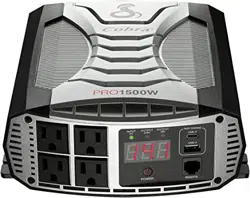Loading ...
Loading ...
Loading ...

11 | Page
Multiply: AC AMPS X 110 (AC Voltage) = WATTS. This formula yields a close approximation of the
continuous load of your appliance.
Multiply: WATTS X 2 = Starting load for most appliances, tools and devices. This formula yields a close
approximation of the starting load for most appliances. Exceptions are motorized appliances such as
pumps, freezers, and air conditioners. These appliances can have startup loads of up to eight times the
rated Watts.
For electrically sensitive equipment, contact the manufacturer to determine if the device you are using is
compatible with modified sine wave AC. If not, then a Pure Sine Wave Inverter is recommended.
Determining the DC Power Requirements
Your inverter requires the input of a 12-Volt battery. To calculate the approximate power in Amps a 12-
Volt battery bank you need to know the current, or Amps required for powering the continuous AC load.
A shortcut method is to divide
the continuous AC load Wattage by 10.
For example, the continuous load
of the PRO 3000W Power Inverter is 3000 Watts
. The current (Amps) is: 3000/10 or 300 Amps at 12
VDC. Add to the
load any DC appliances that may be powered by the battery bank.
MOUNTING THE INVERTER
Do not mount the power inverter under the hood of any vehicle. Choose a cool, dry, and well-ventilated
area inside the vehicle as close to the battery as possible. Place the power inverter on a flat, secure
surface. Make sure there are no wires, fuel lines or fluid tanks directly behind the wall or surface being
drilled. When mounting, secure the power inverter in place using corrosion-resistant mounting hardware
(not included).
What you will need:
• Assess your mounting needs depending
on the inverter and type of surface you
are mounting (i.e. wood or fiber glass)
• Gather the necessary tools depending
on the surface (i.e. drill or screwdriver)
• Determine size of mounting hardware.
Use only corrosive resistant screws (not included)
Mounting Instructions:
1. Make sure the inverter is OFF.
2. Check for wires, fuel lines or fluid tanks behind the wall or surface you plan to drill.
3. Position the power inverter horizontally when choosing the mounting location. If mounted on a wall
be sure the front of the inverter is facing out. Do not mount vertically to prevent debris or dust from
falling into the power inverter.
4. Mark the locations of the mounting screws before drilling.
5. Remove the inverter and drill the (4) mounting holes.
6. Fasten the inverter to the mounting surface using corrosion-resistant screws (not included).
Loading ...
Loading ...
Loading ...
